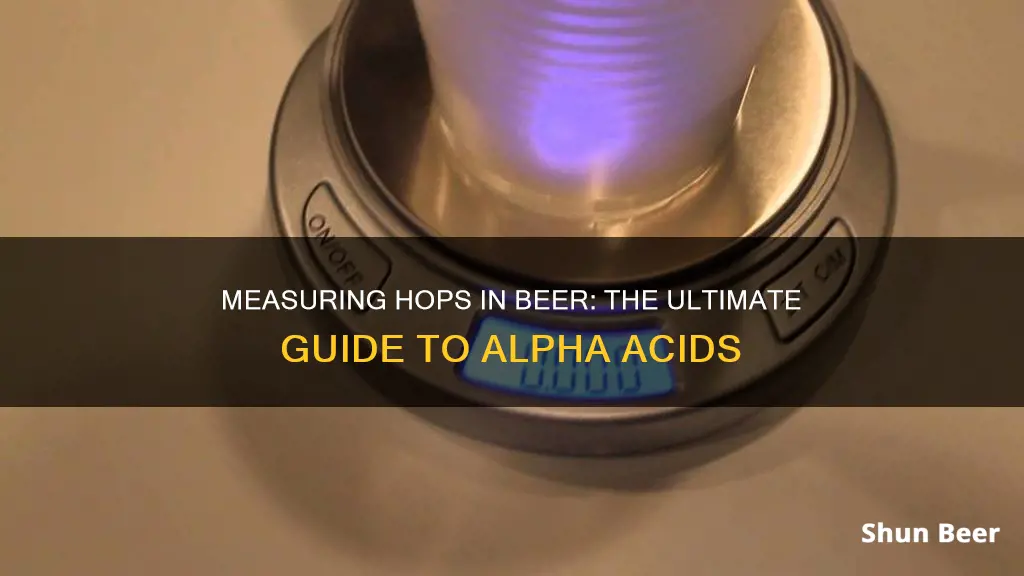
Beer drinkers are spoilt for choice, with a variety of flavours, colours, bitterness levels, and alcohol content to choose from. One of the key factors that determine the overall taste of a beer is the hops content. Hops are a precious and increasingly expensive commodity, and using the right amount can make or break a beer. So, how do we measure hops in beer? The answer lies in International Bitterness Units (IBUs). IBUs are the internationally agreed-upon standard for measuring bitterness in beer, with one IBU roughly equalling one milligram of iso-alpha acids per litre of beer. While IBUs do not indicate flavour, aroma, or perceived bitterness, they are an important quality control measurement for brewers to ensure consistency in their beers.
| Characteristics | Values |
|---|---|
| Standard for measurement | International Bitterness Units (IBU) |
| IBU range | 5 (very low bitterness) to 120 (very high bitterness) |
| IBU calculation | Quantity of material in wort or beer derived from hop resin (alpha acids) x 5/7 |
| IBU calculation (simplified) | IBUs = U% * (ALPHA% * W_OZ * 0.7489) / (V_Gal) |
| IBU measurement | Spectrophotometry, ultraviolet light (UV) spectrophotometric assay, high-pressure liquid chromatography (HPLC) |
| Beer styles with IBU ranges | American mass market lagers (5-10 IBUs), Bavarian hefeweizens (8-12 IBUs), amber lagers (20-25 IBUs), American pale ales (35-40 IBUs), American India pale ales (55-70 IBUs), double IPAs and American barley wines (65-100 IBUs) |
What You'll Learn

International Bitterness Units (IBUs)
IBUs are calculated using the quantity of material in wort or beer derived from hop resin (alpha acids) multiplied by the fraction 5/7. The IBU method was developed in the 1950s and 1960s when most brewers used unrefrigerated baled hops, which often lost a significant amount of their alpha acid-derived bittering potential by the time they were used in the brew kettle. The true bitterness in beer did not correlate well with a simple measurement of its iso-alpha acids, so the IBU analysis was created to overcome this discrepancy.
IBUs are often featured on craft beer labels as a helpful flavour guide, but they do not indicate the perceived bitterness, flavour, or aroma of the beer. While there is generally a correlation between IBUs and experienced bitterness, the perceived bitterness of beer can be very different. This is because beer is about the balance of ingredients and taste, and the perceived bitterness depends on other factors such as malt character, malt sweetness, alcohol content, and individual taste sensitivity.
IBUs are an important quality control measurement for brewers to define beer flavour and ensure consistency from batch to batch. However, their usefulness to the beer consumer is highly debatable. Once the beer leaves the laboratory context, many non-iso alpha acid factors, including other hop components, roast character, carbonation, water chemistry, and residual sugar, may influence the beer's actual perceived bitterness.
Hops' Role in Brewing: Aromatic and Bitter Beer Balancing
You may want to see also

Home Bitterness Units (HBUs)
Homebrew Bitterness Units (HBUs) are a simple way for home brewers to determine the amount of hops required to achieve a specific level of bitterness in a beer. The number of HBUs in a beer is calculated by multiplying the number of ounces of hops used by the alpha acid value of the hops. Alpha acids are the active ingredient that provides the bitterness.
For example, if a 5-gallon beer recipe requires 10 HBUs, and you are using a hop with a 4% alpha acid content, you will need 2.5 ounces of hops (10 HBUs divided by 4% alpha acid content). Different hop varieties have different alpha acid levels, so adjustments will be needed to achieve the same bitterness level.
While HBUs are easy to calculate, they are not very accurate. The actual bitterness of a beer depends on other factors, such as the efficiency of the boil in converting alpha acids to iso-alpha acids, the time of hop addition, the size of the batch, and the boil time. A more accurate method to determine beer bitterness is the International Bitterness Unit (IBU).
IBUs are the internationally agreed-upon standard for measuring bitterness in beer. One IBU is equal to 1 milligram of isomerized alpha acid per litre of wort or beer, or 1 part per million of isomerized alpha acid. This is based on a chemical definition of the actual bitterness chemical, iso-alpha acid, present per litre.
Measuring IBUs requires complicated laboratory techniques, such as ultraviolet light spectrophotometric assay or high-pressure liquid chromatography (HPLC). However, home brewers often use equations to estimate IBU content, taking into account factors like hop utilisation, boil time, and hop weight.
Hops in Beer: Necessary or Overrated?
You may want to see also

Alpha acids
Common alpha acids include humulone, adhumulone, cohumulone, posthumulone, and prehumulone. The alpha acid level of hops is measured in a laboratory. When dissolved in beer as iso-alpha acids, the unit of measurement for bitterness is International Bitterness Units (IBUs). IBUs are the internationally agreed-upon standard for measuring bitterness in beer. The IBU method was developed in the 1950s and 1960s when most brewers used unrefrigerated baled hops, which had lost a significant amount of their alpha acid-derived bittering potential by the time they were used in the brew kettle. The IBU analysis was developed to overcome this discrepancy.
The choice of a hop variety used in beer brewing depends on the beer style. For instance, lager styles use hop varieties with a low alpha acid content, while IPA styles use hop varieties with a high alpha acid content.
The Magic of Hops: Unlocking Beer's Bitter Notes
You may want to see also

Hop utilisation
The utilisation of hops is affected by the vigour and duration of the boil. A longer boil generally means more bitter resins will be isomerised. The pH of the wort also affects hop utilisation, with a higher pH leading to greater isomerisation. The ideal flavour is achieved when the wort pH is between 5.0 and 5.4. In high-gravity worts, the concentration of sugars acts to block isomerisation, so more hops are needed for high-gravity beers to achieve a similar bitterness to a normal-strength beer.
The form of the hops also makes a difference, with pellets giving better utilisation than whole cones. The gravity of the wort and the level of agitation in the boil will also affect hop utilisation.
The only way to truly know a beer's bitterness is to measure the International Bitterness Units (IBUs) directly. This is done using a method standardised by the American Society of Brewing Chemists, which involves separating iso-alpha acids and measuring their levels using an ultraviolet spectrometer.
Importing Azacca Hops to BeerSmith: A Step-by-Step Guide
You may want to see also

Beer style guides
IBUs are a chemical measurement of the number of bittering compounds, specifically isomerized and oxidised alpha acids, polyphenols, and a few other bittering chemicals, that make your beer taste bitter. The IBU scale was introduced in the early 20th century and has evolved as a way to quantify the perception of bitterness in a beer.
The strict definition of an IBU is simple: one IBU is roughly one milligram of iso-alpha acids per litre of beer. However, the actual calculation of IBUs is complex and requires a spectrophotometer and solvent extraction. The formula for calculating IBUs is:
> IBUs = U% * (ALPHA% * W_OZ * 0.7489) / (V_Gal)
Where:
- U% is the hop utilisation percentage, which varies depending on equipment used, brewing methods, boil time, boil size, and boil gravity
- ALPHA% is the percentage of alpha acid in the hop variety
- W_OZ is the weight of the hops in ounces
- V_GAL is the volume of hops in gallons
It's important to note that the above formula gives the IBUs for a single hop addition. If you have multiple hop additions, you need to add up the IBUs from each addition.
While the IBU scale is a useful tool for brewers, it's important to remember that it doesn't indicate flavour, aroma, or perceived bitterness. The bitterness of a beer also depends on other factors such as malt character, roast character, carbonation, water chemistry, and residual sugar. Therefore, a beer with a higher IBU value is not necessarily an indication of a more bitter-tasting beer.
Identifying Hops in Beer: A Guide to Flavor and Aroma
You may want to see also
Frequently asked questions
Hops are the source of beer's bitter taste. Raw hop cones contain alpha acids, a class of chemical compounds that are not very bitter. However, when heat is applied during the brewing process, these acids isomerize, changing their physical structure but maintaining their elemental composition. The resulting iso-alpha acids are much more bitter, and these are measured on the IBU scale.
The most common and widely used way to measure hops in beer is through spectrophotometry. In this process, hops are boiled in wort to promote isomerization. Since the iso-alpha acids are slightly hydrophobic, a reduction of the pH by adding acid increases the hydrophobicity of the iso-alpha acids. At this point, an organic solution is added, and the iso-alpha acids shift to the organic layer out of the aqueous wort. This new solution is then placed in a spectrophotometer, and the absorbance is read at 275 nm.
The International Bitterness Unit (IBU) scale is an internationally agreed-upon standard for measuring bitterness in beer. The strict definition is a chemical measurement of the number of bittering compounds, specifically isomerized and oxidized alpha acids, polyphenols, and a few other select bittering chemicals that make your beer taste bitter.







